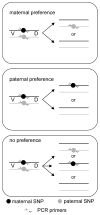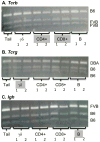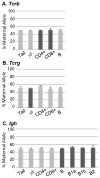Chromosome choice for initiation of V-(D)-J recombination is not governed by genomic imprinting
- PMID: 28244489
- PMCID: PMC5788196
- DOI: 10.1038/icb.2017.1
Chromosome choice for initiation of V-(D)-J recombination is not governed by genomic imprinting
Abstract
V-(D)-J recombination generates the antigen receptor diversity necessary for immune cell function, while allelic exclusion ensures that each cell expresses a single antigen receptor. V-(D)-J recombination of the Ig, Tcrb, Tcrg and Tcrd antigen receptor genes is ordered and sequential so that only one allele generates a productive rearrangement. The mechanism controlling sequential rearrangement of antigen receptor genes, in particular how only one allele is selected to initiate recombination while at least temporarily leaving the other intact, remains unresolved. Genomic imprinting, a widespread phenomenon wherein maternal or paternal allele inheritance determines allele activity, could represent a regulatory mechanism for controlling sequential V-(D)-J rearrangement. We used strain-specific single-nucleotide polymorphisms within antigen receptor genes to determine if maternal vs paternal inheritance could underlie chromosomal choice for the initiation of recombination. We found no parental chromosomal bias in the initiation of V-(D)-J recombination in T or B cells, eliminating genomic imprinting as a potential regulator for this tightly regulated process.
Conflict of interest statement
The authors declare no conflict of interest.
The authors have no competing financial interests to report.
Figures



Similar articles
-
Inefficient V(D)J recombination underlies monogenic T cell receptor β expression.Proc Natl Acad Sci U S A. 2020 Aug 4;117(31):18172-18174. doi: 10.1073/pnas.2010077117. Epub 2020 Jul 20. Proc Natl Acad Sci U S A. 2020. PMID: 32690689 Free PMC article.
-
It takes two: communication between homologous alleles preserves genomic stability during V(D)J recombination.Nucleus. 2010 Jan-Feb;1(1):23-9. doi: 10.4161/nucl.1.1.10595. Nucleus. 2010. PMID: 21327101 Free PMC article.
-
Poor-Quality Vβ Recombination Signal Sequences and the DNA Damage Response ATM Kinase Collaborate to Establish TCRβ Gene Repertoire and Allelic Exclusion.J Immunol. 2022 Jun 1;208(11):2583-2592. doi: 10.4049/jimmunol.2100489. Epub 2022 May 9. J Immunol. 2022. PMID: 35534211 Free PMC article.
-
Illegitimate V(D)J recombination involving nonantigen receptor loci in lymphoid malignancy.Genes Chromosomes Cancer. 2012 Jun;51(6):525-35. doi: 10.1002/gcc.21942. Epub 2012 Feb 15. Genes Chromosomes Cancer. 2012. PMID: 22334400 Free PMC article. Review.
-
Long-Range Control of V(D)J Recombination & Allelic Exclusion: Modeling Views.Adv Immunol. 2015;128:363-413. doi: 10.1016/bs.ai.2015.08.002. Epub 2015 Sep 19. Adv Immunol. 2015. PMID: 26477371 Review.
Cited by
-
Addressing Technical Pitfalls in Pursuit of Molecular Factors That Mediate Immunoglobulin Gene Regulation.J Immunol. 2024 Sep 1;213(5):651-662. doi: 10.4049/jimmunol.2400131. J Immunol. 2024. PMID: 39007649 Free PMC article.
References
-
- Malissen M, Trucy J, Jouvin-Marche E, Cazenave P, Scollay R, Malissen B. Regulation of TCR alpha and beta gene allelic exclusion during T-cell development. Immunol Today. 1992;13:315–22. - PubMed
-
- Outters P, Jaeger S, Zaarour N, Ferrier P. Long-range control of V(D)J recombination and allelic exclusion: modelling views. Adv Immunol. 2015;128:363–413. - PubMed
-
- Jackson A, Krangel M. Turning T-cell receptor beta recombination on and off: more questions than answers. Immunol Rev. 2006;209:129–41. - PubMed
-
- Khor B, Sleckman B. Allelic exclusion at the TCRbeta locus. Curr Opin Immunol. 2002;14:230–34. - PubMed
-
- Michie A, Zuniga-Pflucker J. Regulation of thymocyte differentiation: pre-TCR signals and beta-selection. Semin Immunol. 2002;14:3311–323. - PubMed
Publication types
MeSH terms
Grants and funding
LinkOut - more resources
Full Text Sources
Other Literature Sources

